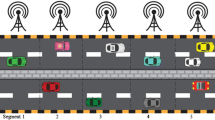Abstract
The analysis of multihop ratio transmission for randomly distributed terminals in the plane has drawn a lot of attention in the literature. Several routing strategies have been investigated concerning throughput and normalized expected progress. Because of mathematically intractable problems all analyses use simulation studies as part of the derivation. In this paper we present a one-dimensional model to investigate the performance of multihop networks. This model seems to be more adequate for applications in road traffic information systems. Three routing strategies ‘most forward with fixed transmission range’, ‘positively most forward with fixed transmission range’, and ‘positively most forward with variable transmission range’ are analyzed on the basis of a complete mathematical description. We also consider directional antennas. The results are presented in closed formulae which are evaluated numerically and depicted in corresponding diagrams. It turns out that adjusted transmission ranges enlarge network performance. Furthermore, some interesting differences to the usual two-dimensional random model occur.
Similar content being viewed by others
References
Y.C. Cheng and T.G. Robertazzi, Critical connectivity phenomena in multihop radio networks, IEEE Trans. Commun. 37 (1989) 770–777.
C. Chang and J. Chang, Optimal design parameters in a multihop packet radio network using random access techniques,Proc. IEEE Globecom (Nov. 1984) pp. 15.5.1–15.5.5.
B. Hajek, Adaptive transmission strategies and routing in mobile radio networks,Proc. Conf. Inform. Sci. Syst. (March 1983) pp. 373–378.
T.C. Hou and V.O.K. Li, Transmission range control in multihop packet radio networks. IEEE Trans. Commun. 34 (1986) 38–44.
L. Kleinrock and J.A. Silvester, Optimum transmission radii for packet radio networks or why six is a magic number,Proc. IEEE Nat. Telecomm. Conf. (Dec. 1978) pp. 4.3.1–4.3.5.
A. Mann and J. Rückert, Transmission range control for packet radio networks or why magic numbers are distance dependent,Proc. 14th IFIP Conf. System Modeling and Optimization, Leipzig (1989).
R. Mathar and J. Mattfeldt, Analyzing routing strategy NFP in multihop packet radio networks on a line, IEEE Trans. Commun. 43 (1995) 977–988.
H.J. Perz and B. Walke, Adjustable transmission power for mobile communications with omnidirectional and directional antennas in a one- and multihop environment,Proc. IEEE VTC 91 (May 1991) pp. 630–635.
L.G. Roberts, ALOHA packet system with and without slots and capture, Comput. Commun. Rev. 5 (1975) 28–42.
H. Takagi and L. Kleinrock, Optimal transmission ranges for randomly distributed packet radio terminals, IEEE TRans. Commun. 32 (1984) 246–257.
R.W. Wolff,Stochastic Modeling and the Theory of Queues (Prentice-Hall, Englewood Cliffs, NJ, 1989).
Author information
Authors and Affiliations
Additional information
This work was supported by the Deutsche Forschungsgemeinschaft under grant no. Ma 1184/2-1.
Rights and permissions
About this article
Cite this article
Mathar, R., Mattfeldt, J. Optimal transmission ranges for mobile communication in linear multihop packet radio networks. Wireless Netw 2, 329–342 (1996). https://doi.org/10.1007/BF01262051
Issue Date:
DOI: https://doi.org/10.1007/BF01262051




